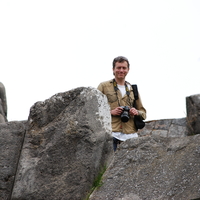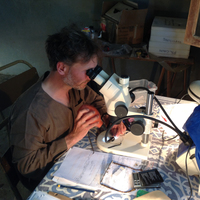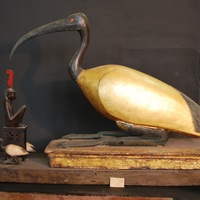Russian Journal of Humanities, Volume 11, Number 3, p. 10-128,, 2019
This article deals with the hieroglyphic inscription on the pharaoh Taharqo’s stela (Kawa V) reco... more This article deals with the hieroglyphic inscription on the pharaoh Taharqo’s stela (Kawa V) recounting natural phenomena and wonders that happened in his sixth regnal year (685/4 BCE). The central events are a remarkably high inundation of the Nile that was attested by the historical evidence on the Karnak quay, and the rainfall in Nubia. A rich harvest and great prosperity of the country were derived from those events. The paper aims to present the text of the stela in Russian and review the previous discussions of the record. The inscription collated with the photo of the stela kept in Copenhagen.Commentary includes a number of improvements for the earlier copies and its translation. Discussion of the key problems is emphasized: the phenomena considered by the earlier researchers as wonders, the dynastic features, the circumstances of Taharqo’s coronation in Memphis.











Uploads
Books by Maxim Panov
The book consists of an Introduction, four chapters, Supplement, Indexes, Plates and Bibliography.
Over one thousand and three hundred items are given in a relatively chronological order, supplied with a brief analysis of the translation (in cases where the text was translated more than once, the most recent version is discussed), and references to the basic publications of the sources.
The book consists of an Introduction, eight chapters, Supplement, Conclusion, Indexes and Bibliography.
Chapter 1. Systematization of the translated records discusses aims and objectives of the research, describes its structure and methodology used to complete the study.
Chapter 2. Historical and Biographical Inscriptions from 3–1 millennium BC. The items are in a chronological sequence and grouped by editions (Urk., KRI, RAD etc.).
Chapter 3. Varia. Rock inscriptions from Dakka and Wadi Allaqi, texts on the seals and scarabs from museums in Russia, Ukraine, the Caucasus and the Baltic states, Late-Egyptian Miscellanies and inscribed amulets from the State Hermitage Museum.
Chapter 4. Historical and Biographical Inscriptions from the Greco-Roman Period .
Chapter 5. Literary Texts: classical literary compositions, literature of the Ramesside period, demotic literature, hymns, texts of various genres.
Chapter 6. Mythological Texts (papyri, healing statues, royal tombs).
Chapter 7. Funerary Texts (Pyramid Texts, Coffin Texts, Book of the Dead, Greco-Roman funerary inscriptions).
Chapter 8. Publications. Ten less-known records from private and museum collections with photos and copy of the inscriptions.
The Supplement provides an index of the records published and/or translated in the volumes ET I–XVI with reference to the volume and chapter number where it may be found.
“The Tale of the Eloquent Peasant”. Transliteration and translation are given for each of the four sources separately.
“The Instruction of Amenemhet I”. The translation is preceded by a separate transliteration for each of the three papyri (Millingen, Sallier I and Sallier II). I have already reviewed F. Adrom’s edition (Panov, 2008), but as the photos of the papyri Sallier as well as the first facsimile (Birch, Hawkins, 1841–1844) have only recently become available to me, some additional discrepancies between Adrom’s copy and the original texts are revealed, and a few critical notes made previously on the second facsimile (Budge, 1923) are dismissed.
“The Instruction of Kheti” (or “Satire of Trades”). The translation is preceded by a separate transliteration for each of the two principal sources (papyri Sallier II and Anastasi VII); a few critical notes on S. Jäger’s, W. Helck’s and H. Brunner’s hieroglyphic transcriptions are made through the collation of the photos (to both papyri and other sources).
“The Hymn to the Nile”. A separate transliteration for each principal source (papyri Sallier II, Anastasi VII, Ch.Beatty V, and ostraca Gol. 4470, IFAO 1176), a synoptic transliteration and translation. A number of critical notes on D. van der Plas’s and W. Helck’s publications of the three manuscripts is made. The colophons of the papyri Sallier II and Anastasi VII are presented at the end of this section.
As a result, the entire papyrus Sallier II is given in transliteration of the three literary compositions, the colophons are presented in a supplement.
“The Book of Kemit”. The first Russian translation.
“The Dialogue of Ipuwer and the Lord of All”. Three earlier hieroglyphic transcriptions are collated with the photos of the papyrus AMS 27 (= Leiden I 344, rt), a number of critical notes is made on R. Enmarch’s edition (not listed in the review by F. Adrom).
“The Prophecies of Neferti”. The study is based on the W. Golénischeff’s facsimile of the Hermitage papyrus and freely avaible photos of other sources; a number of critical notes on the hieroglyphic transcriptions published in the previous editions is made.
Chapter 2 “Historical and Biographical Inscriptions of the 16th–19th Dynasties” includes forty-four records, the major part of which dates to the 18th dynasty. They are:
a document of the office sale “The Juridical Stela” (Caire JE 52453), the decree of Antef VII (Caire JE 30770bis), various records from the reign of Ahmose I, the Tombos stela of Thutmose I, inscriptions commemorating the victories of Thutmose II and Thutmose III, selected records from Semna, the poem of victory on the stela of Thutmose III, the inscription on the obelisk of Thutmose III and Ramesses II (Cleopatra’s Needle) now in New York, the stela describing the campaign of Amenhotep III in Kush (BM 657), the text describing the building activity of Amenhotep III in Karnak, the rock inscription of Thutmose IV on Konosso island, the donation stela of Ay. Records of non-royal persons include inscriptions from the tombs of Ahmose-Pennekhbet and Paheri at el-Kab, the tomb of Ineni (TT 81), the tomb of Hui (TT 40), the tomb of Tutu at el-Amarna, graffiti and the stela of Turi, the viceroy of Kush, the texts from the tomb of Djehuti at Kom el-Ahmar and the tomb of Neferhotep (TT 50), including the so-called Harper’s songs, two graffiti from KV 43.
Chapter 3 “Literary Compositions of the 18th–19th Dynasties” includes three papyri. They are:
AMS 23a (= Leiden I 346) with a chapter “The Epagomenal days”;
BM 10184, rt (= Sallier IV) with “The Calendar of Lucky and Unlucky Days”;
BM 10689 (= Ch.Beatty IX) with a ceremonial manual “The Ritual of Amenhotep I”.
The Supplement provides newly refined hieroglyphic transcriptions of:
the papyrus ÄM 10499, 1,1–10,7rt (= Peas R) with photos;
the papyrus BM 10185 (= Sallier I), 9vs;
the papyrus BM 10182 (= Sallier II);
the papyrus Amherst XIV (“Satire of Trades”);
the papyrus BM 10222 (= Anastasi VII), 1,1–7,6 (“Satire of Trades”);
the ostracon UC 39637 (“The Prophecies of Neferti”) with photo;
the ostraca UC 31911, 31912, 31913, 31927 (“Kemit”) with photos;
the stela Caire JE 52453 (“The Juridical Stela”);
the inscriptions from the tomb of Neferhotep (TT 50) with photos;
the papyrus AMS 23a (= Leiden I 346), 2,5–3,8.
The book consists of an Introduction, three chapters, Supplement, Indexes and Bibliography. All translations are accompanied by transliteration and comments if necessary.
Chapter 1 “Inscriptions from the Eleventh Dynasty” includes nineteen records. The most remarkable are inscriptions from the Siut tombs (nos. V, III, IV), Ankhtifi’s tomb (el-Mo’alla), Irtisen’s story (stela Louvre C 4), the rock inscription of Henu (WH 114).
Chapter 2 “Inscriptions from the Twelfth Dynasty” includes thirty two records. The most remarkable are rock inscriptions from Wadi Hammamat (no. 199) and Sinai (no. 90), insriptions from the tombs at Beni Hasan (nos. 14, 2, 3) and Siut (no. I), Sehetepibre’s stela with the loyalist teaching (CGC 20538), inscriptions from Djehutihotep’s tomb (el-Bersheh 2).
Chapter 3 “Inscriptions from the Second Intermediate Period” includes thirteen records. The most remarkable are the royal decree (Caire JE 51911); two stelae of Neferhotep I (Caire JE 32556, Caire JE 6307) and two inscriptions of Kamose (Caire JE 41790, Caire TE 11/1/35/1, Luxor J 43).
The Supplement provides several photos (from Ankhtifi’s tomb, rock inscription WH 199 and stela Leiden V 4 (= AP 63).
The selected texts are preserved on different types of sources: funerary stelae, obelisks, statues, papyri, graffiti. Though these texts are known in English, German or French translations, they have been little-known for Russian readers. Both earlier and recent editions of the monuments have been studied; a major part of the inscriptions are photo collated.
The book consists of an Introduction, three chapters, Supplement, Indexes, and Bibliography. All translations are accompanied by transliteration and comments if necessary.
Chapter 1 “Inscriptions of the VI–IV centuries BC” includes twenty texts.
The most remarkable are the stelae of Hor and Padihoremheb (Louvre C 317, IM 4018), the
healing statue Louvre E 10777 (with a copy of hieroglyphic inscriptions); Djedher’s story
about his responsibility for the care of falcons (Cairo JE 46341); the anthropoid sarcophagi
Pushkin I.1.a.5314 and I.1.a.5313 (with a copy of hieroglyphic inscriptions).
Chapter 2 “Inscriptions of the Ptolemaic Period” includes twenty texts.
The most remarkable are: two statues and a gnomon of Zenon (CGC 70031 + RT 31/3/64/1,
BM 1668, UC 16376), the document of Thot (Edfu VI, 199–201); the stela of Tashet from
Akhmim; the stela of Nedesh (Leiden AP 1); the stelae of Hor and Padihorpakhered (Vienna
5103, Louvre C 232 with a copy of hieroglyphic inscriptions).
Chapter 3 “Inscriptions of the Roman and Byzantine Periods” includes twenty texts.
The most remarkable are: two hymns to Imhotep (from Thebes); the obelisk of Antinous (also known as Barberini); the divine decree on Abaton; the Buchis stela (Cairo JE 31901) and selected graffiti from Philae.
The Supplement includes the list of personal names (hieroglyphic) mentioned in the inscriptions under discussion; the study of the additional sources to the corpus of the objects discussed in ET VII: six blocks and ushabti figures from the tomb of Wennefer in Saqqara; the publication of the photos (stelae Leiden AP 1, Vienna 5103, Louvre C 232, Leiden CI 327, Berlin 22489).
Hieratic texts, the so-called Late-Egyptian Miscellanies, are well-known for the readers and well-studied by researchers. Few the most impressive records were translated into Russian by I. Lur’e, M. Korostovtsev, O. Berlev and others. The present volume offers the
first Russian translation of the whole corpus of Late-Egyptian Miscellanies. Moreover, these modern interpretations, based mainly on A.H. Gardiner’s edition, have also drawn on other publications and studies, including the most recent discussions.
The aim of this work is to present all contents of every source, for this reason the texts are given in the same order as they are written in the papyrus and various versions of the same text found in different sources are included; only apparent errors are corrected and lacunae are not restored after well-preserved copies.
Major part of the texts is short compositions of different literary or documentary types:
letters or letter models, didactic excerpts, eulogy to the king or the residence. The only exceptions included in this volume are “Hymn to Amun-Re” from papyrus Ch.Beatty IV and the tale “Seqenenra and Apopis” from papyrus Sallier I.
The book consists of an Introduction, two chapters, Supplement, Indexes and Bibliography. All translations are accompanied by transliteration and comments if necessary.
Chapter 1 “Manuscripts from Memphis” includes the papyri:
Bologna, Anastasi II, Anastasi III, Anastasi IIIA, Anastasi IV, Anastasi V,
Anastasi VI, Anastasi VIII, Anastasi IX, Sallier I, Sallier IV, vs, Koller, Turin A, Leiden I 348, Rainer 53.
Chapter 2 “Manuscripts from Thebes” includes the papyri:
Lansing, Turin B, Turin C, Turin D, Ch.Beatty III, Ch.Beatty IV, Ch.Beatty V.
The Supplement provides paleographic notes on the papyrus of entauret (Sallier III) with a newly constructed hieroglyphic transcription of the colophon.
The records are arranged in chronological order, translations are prefaced with a general description of the source and relevant concise bibliography, texts are given in transliteration and the most uncertain or disputable readings have commentaries.
The book consists of an Introduction, three chapters, Indexes, Bibliography and Supplement.
Chapter 1 “Legends and Myths” includes eight ancient literary works. They are:
“The Tale of the Two Brothers” (papyrus d’Orbiney);
“The Contendings of Horus and Seth” (papyrus Ch.Beatty I, rt);
“The Story of Truth and Falsehood” (papyrus Ch.Beatty II);
“The Legend of Mankind's Plot against Re” (from “The Book of the Heavenly Cow”, after the version in the tomb of Sethos I);
“The Story of the Spirit” (Ramesside ostraca);
“Legends of the Delta region” (papyrus Brooklyn 47.218.84);
“The Story of the Reigns of Shu and Geb” (naos Ismailia 2248, “el-Arish”);
“Records of Names Origin and Meanings” (papyrus Louvre E 17110, “Jumilhac”).
Chapter 2 “Hymns” includes two ancient literary works. They are:
“Hymns to the crowns” (papyrus Pushkin I.1.b.314);
“The Hymn to Amun-Re” (papyrus Berlin 3049).
Chapter 3 “Reports” includes three research works. They are:
“On Meanings Getting Lost in Translation from Ancient Egyptian”
The first report focuses on the problems of the theory of translation with reference to Ancient Egyptian language and deals with typical shortcuts and misreadings of the original meaning that occurs in translations of hieroglyphic inscriptions. Theoretical statements are followed by a wide range of practical material collected by the author during his long experience of translation; new interpretations for several well-known inscriptions are suggested.
The paper is mainly addressed to those Russian orientalists who are not specialized in Egyptology, since the poor quality of Russian translations, due to the lack of Ancient Egyptian dictionaries and grammar books in Russian, narrows opportunities for an independent study. The differences between ancient and modern cultures of writing are analyzed through comparison of the main principles used for the composition of a hieroglyphic text and the patterns of its arrangement in a target language. Standards of transformation occurring over text representation, discrepancy between languages, a literal translation and cases of misunderstanding of the initial meaning are discussed.
“The Naophoros Statue of Harsiese”
The second report is a revised edition of the statue of vizier Harsiese (Berlin 21596), Dynasty 30. A new study of the monument, already discussed in the seventh volume of the series with Russian translation (cf. ET VII, 125–128), is based on the latter-day photos. The text is presented in transliteration and English translation accompanied by commentaries.
“Demotic Inscriptions on a Writing Board”
The third report is devoted to the publication of the writing board with demotic inscriptions found by the Russian archaeological expedition in the Fayum Oasis in 2009. The text is the final part of the document containing the list of people and provisions they received.
The Supplement “Editions” contains a complete set of photos of three sources discussed in the book:
papyrus Louvre E 17110; statue Berlin 21596; writing board CESRAS 2009/0201/1.
In the Late period women acquired their own funeral stelae and the possibility to create and record their life stories. Appearing in approximately the seventh century BC this tendency was realized in dozens of monuments. Women succeeded in acquiring freedom to leave their records for new generations, which was the case when they were able to reveal their personality.
The present work deals with one aspect of the topic; conclusions are based on the author’s interpretations of the inscriptions and classification of the sources: women on men’s monuments, objects with funerary inscriptions, statuettes, stelae with short inscriptions, stelae with biographies.
Theoretical statements are followed by a wide range of practical material; the study is based on the available editions of the inscriptions collated with the originals or their museum photos.
The list of names and the list of female epithets that has never been compiled before are a valuable part of this research.
The Supplement contains: stelae Louvre C 317 [persian] (photos, transliteration, translation, comments); BM 147 [ptolemaic] (hand-copy, transliteration and translation); BM 392 [ptolemaic] (transliteration and translation).
The book consists of an Introduction, four chapters, Supplement, Indexes, Plates and Bibliography.
Over one thousand and three hundred items are given in a relatively chronological order, supplied with a brief analysis of the translation (in cases where the text was translated more than once, the most recent version is discussed), and references to the basic publications of the sources.
The book consists of an Introduction, eight chapters, Supplement, Conclusion, Indexes and Bibliography.
Chapter 1. Systematization of the translated records discusses aims and objectives of the research, describes its structure and methodology used to complete the study.
Chapter 2. Historical and Biographical Inscriptions from 3–1 millennium BC. The items are in a chronological sequence and grouped by editions (Urk., KRI, RAD etc.).
Chapter 3. Varia. Rock inscriptions from Dakka and Wadi Allaqi, texts on the seals and scarabs from museums in Russia, Ukraine, the Caucasus and the Baltic states, Late-Egyptian Miscellanies and inscribed amulets from the State Hermitage Museum.
Chapter 4. Historical and Biographical Inscriptions from the Greco-Roman Period .
Chapter 5. Literary Texts: classical literary compositions, literature of the Ramesside period, demotic literature, hymns, texts of various genres.
Chapter 6. Mythological Texts (papyri, healing statues, royal tombs).
Chapter 7. Funerary Texts (Pyramid Texts, Coffin Texts, Book of the Dead, Greco-Roman funerary inscriptions).
Chapter 8. Publications. Ten less-known records from private and museum collections with photos and copy of the inscriptions.
The Supplement provides an index of the records published and/or translated in the volumes ET I–XVI with reference to the volume and chapter number where it may be found.
“The Tale of the Eloquent Peasant”. Transliteration and translation are given for each of the four sources separately.
“The Instruction of Amenemhet I”. The translation is preceded by a separate transliteration for each of the three papyri (Millingen, Sallier I and Sallier II). I have already reviewed F. Adrom’s edition (Panov, 2008), but as the photos of the papyri Sallier as well as the first facsimile (Birch, Hawkins, 1841–1844) have only recently become available to me, some additional discrepancies between Adrom’s copy and the original texts are revealed, and a few critical notes made previously on the second facsimile (Budge, 1923) are dismissed.
“The Instruction of Kheti” (or “Satire of Trades”). The translation is preceded by a separate transliteration for each of the two principal sources (papyri Sallier II and Anastasi VII); a few critical notes on S. Jäger’s, W. Helck’s and H. Brunner’s hieroglyphic transcriptions are made through the collation of the photos (to both papyri and other sources).
“The Hymn to the Nile”. A separate transliteration for each principal source (papyri Sallier II, Anastasi VII, Ch.Beatty V, and ostraca Gol. 4470, IFAO 1176), a synoptic transliteration and translation. A number of critical notes on D. van der Plas’s and W. Helck’s publications of the three manuscripts is made. The colophons of the papyri Sallier II and Anastasi VII are presented at the end of this section.
As a result, the entire papyrus Sallier II is given in transliteration of the three literary compositions, the colophons are presented in a supplement.
“The Book of Kemit”. The first Russian translation.
“The Dialogue of Ipuwer and the Lord of All”. Three earlier hieroglyphic transcriptions are collated with the photos of the papyrus AMS 27 (= Leiden I 344, rt), a number of critical notes is made on R. Enmarch’s edition (not listed in the review by F. Adrom).
“The Prophecies of Neferti”. The study is based on the W. Golénischeff’s facsimile of the Hermitage papyrus and freely avaible photos of other sources; a number of critical notes on the hieroglyphic transcriptions published in the previous editions is made.
Chapter 2 “Historical and Biographical Inscriptions of the 16th–19th Dynasties” includes forty-four records, the major part of which dates to the 18th dynasty. They are:
a document of the office sale “The Juridical Stela” (Caire JE 52453), the decree of Antef VII (Caire JE 30770bis), various records from the reign of Ahmose I, the Tombos stela of Thutmose I, inscriptions commemorating the victories of Thutmose II and Thutmose III, selected records from Semna, the poem of victory on the stela of Thutmose III, the inscription on the obelisk of Thutmose III and Ramesses II (Cleopatra’s Needle) now in New York, the stela describing the campaign of Amenhotep III in Kush (BM 657), the text describing the building activity of Amenhotep III in Karnak, the rock inscription of Thutmose IV on Konosso island, the donation stela of Ay. Records of non-royal persons include inscriptions from the tombs of Ahmose-Pennekhbet and Paheri at el-Kab, the tomb of Ineni (TT 81), the tomb of Hui (TT 40), the tomb of Tutu at el-Amarna, graffiti and the stela of Turi, the viceroy of Kush, the texts from the tomb of Djehuti at Kom el-Ahmar and the tomb of Neferhotep (TT 50), including the so-called Harper’s songs, two graffiti from KV 43.
Chapter 3 “Literary Compositions of the 18th–19th Dynasties” includes three papyri. They are:
AMS 23a (= Leiden I 346) with a chapter “The Epagomenal days”;
BM 10184, rt (= Sallier IV) with “The Calendar of Lucky and Unlucky Days”;
BM 10689 (= Ch.Beatty IX) with a ceremonial manual “The Ritual of Amenhotep I”.
The Supplement provides newly refined hieroglyphic transcriptions of:
the papyrus ÄM 10499, 1,1–10,7rt (= Peas R) with photos;
the papyrus BM 10185 (= Sallier I), 9vs;
the papyrus BM 10182 (= Sallier II);
the papyrus Amherst XIV (“Satire of Trades”);
the papyrus BM 10222 (= Anastasi VII), 1,1–7,6 (“Satire of Trades”);
the ostracon UC 39637 (“The Prophecies of Neferti”) with photo;
the ostraca UC 31911, 31912, 31913, 31927 (“Kemit”) with photos;
the stela Caire JE 52453 (“The Juridical Stela”);
the inscriptions from the tomb of Neferhotep (TT 50) with photos;
the papyrus AMS 23a (= Leiden I 346), 2,5–3,8.
The book consists of an Introduction, three chapters, Supplement, Indexes and Bibliography. All translations are accompanied by transliteration and comments if necessary.
Chapter 1 “Inscriptions from the Eleventh Dynasty” includes nineteen records. The most remarkable are inscriptions from the Siut tombs (nos. V, III, IV), Ankhtifi’s tomb (el-Mo’alla), Irtisen’s story (stela Louvre C 4), the rock inscription of Henu (WH 114).
Chapter 2 “Inscriptions from the Twelfth Dynasty” includes thirty two records. The most remarkable are rock inscriptions from Wadi Hammamat (no. 199) and Sinai (no. 90), insriptions from the tombs at Beni Hasan (nos. 14, 2, 3) and Siut (no. I), Sehetepibre’s stela with the loyalist teaching (CGC 20538), inscriptions from Djehutihotep’s tomb (el-Bersheh 2).
Chapter 3 “Inscriptions from the Second Intermediate Period” includes thirteen records. The most remarkable are the royal decree (Caire JE 51911); two stelae of Neferhotep I (Caire JE 32556, Caire JE 6307) and two inscriptions of Kamose (Caire JE 41790, Caire TE 11/1/35/1, Luxor J 43).
The Supplement provides several photos (from Ankhtifi’s tomb, rock inscription WH 199 and stela Leiden V 4 (= AP 63).
The selected texts are preserved on different types of sources: funerary stelae, obelisks, statues, papyri, graffiti. Though these texts are known in English, German or French translations, they have been little-known for Russian readers. Both earlier and recent editions of the monuments have been studied; a major part of the inscriptions are photo collated.
The book consists of an Introduction, three chapters, Supplement, Indexes, and Bibliography. All translations are accompanied by transliteration and comments if necessary.
Chapter 1 “Inscriptions of the VI–IV centuries BC” includes twenty texts.
The most remarkable are the stelae of Hor and Padihoremheb (Louvre C 317, IM 4018), the
healing statue Louvre E 10777 (with a copy of hieroglyphic inscriptions); Djedher’s story
about his responsibility for the care of falcons (Cairo JE 46341); the anthropoid sarcophagi
Pushkin I.1.a.5314 and I.1.a.5313 (with a copy of hieroglyphic inscriptions).
Chapter 2 “Inscriptions of the Ptolemaic Period” includes twenty texts.
The most remarkable are: two statues and a gnomon of Zenon (CGC 70031 + RT 31/3/64/1,
BM 1668, UC 16376), the document of Thot (Edfu VI, 199–201); the stela of Tashet from
Akhmim; the stela of Nedesh (Leiden AP 1); the stelae of Hor and Padihorpakhered (Vienna
5103, Louvre C 232 with a copy of hieroglyphic inscriptions).
Chapter 3 “Inscriptions of the Roman and Byzantine Periods” includes twenty texts.
The most remarkable are: two hymns to Imhotep (from Thebes); the obelisk of Antinous (also known as Barberini); the divine decree on Abaton; the Buchis stela (Cairo JE 31901) and selected graffiti from Philae.
The Supplement includes the list of personal names (hieroglyphic) mentioned in the inscriptions under discussion; the study of the additional sources to the corpus of the objects discussed in ET VII: six blocks and ushabti figures from the tomb of Wennefer in Saqqara; the publication of the photos (stelae Leiden AP 1, Vienna 5103, Louvre C 232, Leiden CI 327, Berlin 22489).
Hieratic texts, the so-called Late-Egyptian Miscellanies, are well-known for the readers and well-studied by researchers. Few the most impressive records were translated into Russian by I. Lur’e, M. Korostovtsev, O. Berlev and others. The present volume offers the
first Russian translation of the whole corpus of Late-Egyptian Miscellanies. Moreover, these modern interpretations, based mainly on A.H. Gardiner’s edition, have also drawn on other publications and studies, including the most recent discussions.
The aim of this work is to present all contents of every source, for this reason the texts are given in the same order as they are written in the papyrus and various versions of the same text found in different sources are included; only apparent errors are corrected and lacunae are not restored after well-preserved copies.
Major part of the texts is short compositions of different literary or documentary types:
letters or letter models, didactic excerpts, eulogy to the king or the residence. The only exceptions included in this volume are “Hymn to Amun-Re” from papyrus Ch.Beatty IV and the tale “Seqenenra and Apopis” from papyrus Sallier I.
The book consists of an Introduction, two chapters, Supplement, Indexes and Bibliography. All translations are accompanied by transliteration and comments if necessary.
Chapter 1 “Manuscripts from Memphis” includes the papyri:
Bologna, Anastasi II, Anastasi III, Anastasi IIIA, Anastasi IV, Anastasi V,
Anastasi VI, Anastasi VIII, Anastasi IX, Sallier I, Sallier IV, vs, Koller, Turin A, Leiden I 348, Rainer 53.
Chapter 2 “Manuscripts from Thebes” includes the papyri:
Lansing, Turin B, Turin C, Turin D, Ch.Beatty III, Ch.Beatty IV, Ch.Beatty V.
The Supplement provides paleographic notes on the papyrus of entauret (Sallier III) with a newly constructed hieroglyphic transcription of the colophon.
The records are arranged in chronological order, translations are prefaced with a general description of the source and relevant concise bibliography, texts are given in transliteration and the most uncertain or disputable readings have commentaries.
The book consists of an Introduction, three chapters, Indexes, Bibliography and Supplement.
Chapter 1 “Legends and Myths” includes eight ancient literary works. They are:
“The Tale of the Two Brothers” (papyrus d’Orbiney);
“The Contendings of Horus and Seth” (papyrus Ch.Beatty I, rt);
“The Story of Truth and Falsehood” (papyrus Ch.Beatty II);
“The Legend of Mankind's Plot against Re” (from “The Book of the Heavenly Cow”, after the version in the tomb of Sethos I);
“The Story of the Spirit” (Ramesside ostraca);
“Legends of the Delta region” (papyrus Brooklyn 47.218.84);
“The Story of the Reigns of Shu and Geb” (naos Ismailia 2248, “el-Arish”);
“Records of Names Origin and Meanings” (papyrus Louvre E 17110, “Jumilhac”).
Chapter 2 “Hymns” includes two ancient literary works. They are:
“Hymns to the crowns” (papyrus Pushkin I.1.b.314);
“The Hymn to Amun-Re” (papyrus Berlin 3049).
Chapter 3 “Reports” includes three research works. They are:
“On Meanings Getting Lost in Translation from Ancient Egyptian”
The first report focuses on the problems of the theory of translation with reference to Ancient Egyptian language and deals with typical shortcuts and misreadings of the original meaning that occurs in translations of hieroglyphic inscriptions. Theoretical statements are followed by a wide range of practical material collected by the author during his long experience of translation; new interpretations for several well-known inscriptions are suggested.
The paper is mainly addressed to those Russian orientalists who are not specialized in Egyptology, since the poor quality of Russian translations, due to the lack of Ancient Egyptian dictionaries and grammar books in Russian, narrows opportunities for an independent study. The differences between ancient and modern cultures of writing are analyzed through comparison of the main principles used for the composition of a hieroglyphic text and the patterns of its arrangement in a target language. Standards of transformation occurring over text representation, discrepancy between languages, a literal translation and cases of misunderstanding of the initial meaning are discussed.
“The Naophoros Statue of Harsiese”
The second report is a revised edition of the statue of vizier Harsiese (Berlin 21596), Dynasty 30. A new study of the monument, already discussed in the seventh volume of the series with Russian translation (cf. ET VII, 125–128), is based on the latter-day photos. The text is presented in transliteration and English translation accompanied by commentaries.
“Demotic Inscriptions on a Writing Board”
The third report is devoted to the publication of the writing board with demotic inscriptions found by the Russian archaeological expedition in the Fayum Oasis in 2009. The text is the final part of the document containing the list of people and provisions they received.
The Supplement “Editions” contains a complete set of photos of three sources discussed in the book:
papyrus Louvre E 17110; statue Berlin 21596; writing board CESRAS 2009/0201/1.
In the Late period women acquired their own funeral stelae and the possibility to create and record their life stories. Appearing in approximately the seventh century BC this tendency was realized in dozens of monuments. Women succeeded in acquiring freedom to leave their records for new generations, which was the case when they were able to reveal their personality.
The present work deals with one aspect of the topic; conclusions are based on the author’s interpretations of the inscriptions and classification of the sources: women on men’s monuments, objects with funerary inscriptions, statuettes, stelae with short inscriptions, stelae with biographies.
Theoretical statements are followed by a wide range of practical material; the study is based on the available editions of the inscriptions collated with the originals or their museum photos.
The list of names and the list of female epithets that has never been compiled before are a valuable part of this research.
The Supplement contains: stelae Louvre C 317 [persian] (photos, transliteration, translation, comments); BM 147 [ptolemaic] (hand-copy, transliteration and translation); BM 392 [ptolemaic] (transliteration and translation).
NB! PDF on hieroglyphica.com.
in Memphis. A synode assembly was gathered to celebrate Ptolemy’s V victory over the rebels and announce tax cuts for citizens
and temples. The main historical source for that event is the famous Rosetta stone, all known ancient copies of the text have been
studied.
inscription on the statue of Ptolemy II Philadelphos from Bubastis,
created several years after a countrywide Egyptian cult dedicated to
Arsinoe II had been established. A new interpretation of the text provides
evidence for Ptolemy II erecting an additional statue in honor of his deceased sister, and adds one more spelling of Arsinoe’s name based on the wordplay ‘Arsinoe = his sister’ to the already known variants. A victorious military journey to the coastal settlements of Asian countries at the beginning of the Second Syrian War (259-257 BCE), accordingly provides an opportunity to reconsider and improve the current reconstruction of the military activities. The historical source under discussion along with the papyri from Zenon’s archive and other Egyptian documents dating to the same period not only show quite clearly that Ptolemy himself took part in that campaign, but also enables the correct dating of the end of the war to the spring of
257 BCE.
bearing evidence of several generations of a Theban priestly dynasty
living in the 4th and 3rd centuries BC. Presumably, the tomb’s owner
Nesbanebdjed(et) performed his duties in the Karnak Temple of Khonsu
under Nectanebo II. The present publication provides an improved copy
of the hieroglyphic inscriptions in TT 190 and discusses the obvious relevance of identifying people with similar names known from the monuments as Nesbanebdjed(et)’s relatives. A list of the personal names is supplied. The statues Cairo JE 37075, JE 36579 and the stelae Budapest MBA 51.1928, Prague MN P 1636 are also discussed, but the stela from Budapest was not considered as a monument belonging to the members of the family in question.
Intermediate Period (XVII century BCE). Inscription copied to the stone slab is a record of the judicial trial that took place
in Thebes. The case dealt with the demand to give back the property valued at 5.5 kg of gold. The subsequent assignment of the nomarch
office to the claimer satisfied the debt. The statement, attested by the officials, and court records mentioned in the text are
an evidence of legal relations in the ancient society. The current Russian translation of the text is published for the first time.
where the date of its composition is recorded. To prove that the text was
written on the papyrus during Merneptah’s reign, the reason why the
epithet ‘great’ was applied to the chief of Ramesses’s II enemies is discussed.
A paleographic analysis of the final text fragment has allowed the
mistakes occurring in the earlier hieroglyphic transcriptions authored bythe foreign researchers to be improved. Thus, a newly constructed hieroglyphic
transcription and Russian translation of the colophon is supplied.
insufficiently studied. A brief review of the earlier research is followed by comments on some arguable
questions.
Firstly, an identification and parentage of the owner of the statue. The author proposes to consider
three priests who are pictured on the chest of the statue to be brothers. While every figure is labeled with a
name and priestly titles, a single filiation “son of N, born to M” could be applied to each person, likewise the words “honored by god”, also inscribed once. Accordingly, Pashribastet and Iseturet were the parents
of Padimaikhsa, Pashrimut and Djedher Pamai.
Secondly, the first spell is addressed to the heart of a person (the word jb “heart” is mistakenly
omitted by G. Lefebvre) who drinks “this water”. Thus, it could suggest that the statue was erected near
some water source.
Third, the last part of the spell “The hand of Atum” (a poor copy of the text with no translation
is given in E. Jelínková-Reymond’s publication) includes an appeal to the deities Shed-Baal (not listed in
LGG) and Repyt. Translation of this magical charm is provided with detailed philological commentary.
Quotations from different sources with a myth about a dwarf-like amulet of Geb and Neith follow
the discussion of the records.
Finally, a comparison of the statue Louvre E 10777 with the statue Naples 1065 leads to the conclusion
that both monuments may have been produced in the same workshop.